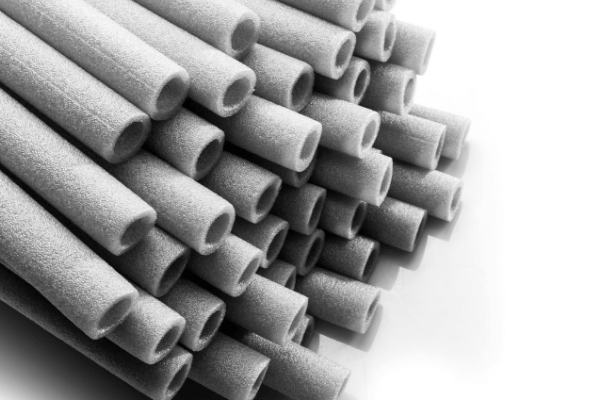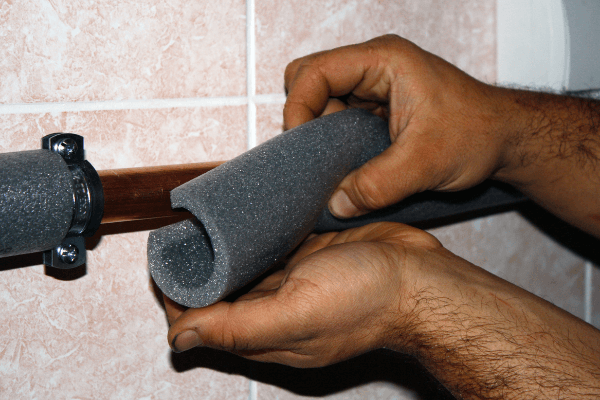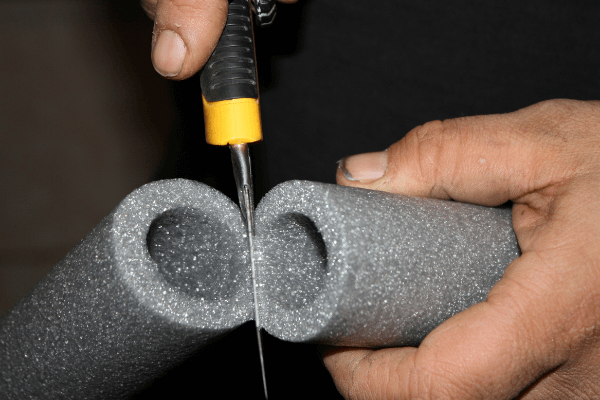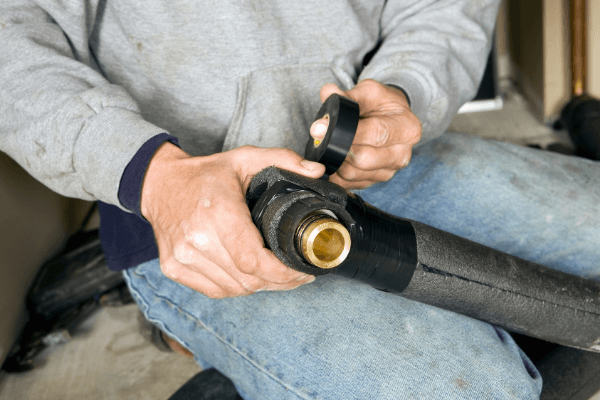- Home
- Domestic Hot Water
- Foam Pipe Insulation
Foam Pipe Insulation
This post may contain affiliate links so I earn a commission.
Installing foam pipe insulation on both your hot and cold water pipes can be an affordable, easy project that will save water and help lower your monthly energy bill.
Did you know in most homes, heating your domestic hot water can account for nearly 20 percent of your energy bill?
Over the course of a year, the amount of money the average home spends on hot water can be surprising.
Polyethylene foam pipe insulation is an inexpensive 3/8'' or 5/8'' thick tube-shaped foam usually sold in 6-foot lengths.

The foam tubes have a slit down the center, which allows the foam to be easily slid over an existing pipe.
The tubes also contain a built-in adhesive strip, which allows you to easily secure the foam over the pipe.
Wrapping your hot and cold water pipes with foam can have many benefits.
The hot water inside your pipes will stay hotter for a longer period of time.
As the hot water inside the pipes sits, it cools.
This requires you to run the hot water for several seconds before the hot water from the tank actually reaches the faucet.
By wrapping the pipe with foam insulation it will help keep the water hot between uses, eliminating the need to just let the water run.
What's The Advantage?
Insulating pipes within your home can provide many advantages, and foam pipe insulation can be used on both cold and hot water pipes.
Minimize Heat Loss
On hot water pipes, foam pipe insulation helps in preventing heat loss.
It keeps the temperature of the water around 2-4 degrees higher than it would on uninsulated pipes.
That means that you require less energy to heat up your water, which saves you money.
Prevent Freezing
On cold water pipes, foam pipe insulation is utilized to prevent your pipes from freezing during the cold season.
Freezing can cause several problems, including blocking your water system, flooding, and cracked pipes.
All these damages are costly to repair.

Insulating your cold water pipes is especially important in underground applications, unheated spaces like lofts, and in your exterior walls.
These areas are more prone to freezing and hard to reach.
Insulation raises the temperature of your pipes and reduces the degree to which extreme weather conditions can affect them.
Prevent Sweating
Foam pipe insulation also helps in eliminating humidity and pipe sweating.
When a cold pipe gets into contact with hot, moist air, the vapor packs on the pipe's surface.
The condensed vapor will drip on the surface below, which can cause rot and mold.
Foam insulation prevents the vapor from condensing on the pipe's surface, minimizing pipe sweating and humidity.
Installing Foam Pipe Insulation
Installing foam pipe insulation is quite easy, but you should follow some steps to ensure that the insulation works well.
Tools required:
- Foam insulation
- Tape measure
- Tape
- Cutting tool
Follow these steps to install your foam insulation:
1. To make sure you have the right size of insulation, measure the diameter of your pipe. Then measure the length of the pipes to know the size of insulation you need.

2.
Cut
the foam pipe insulation to the length needed and slide it over your pipe. To
seal the foam insulation, add an adhesive. It is also recommended that you use
insulating tape to fasten adjoining pieces of foam insulation
together.
Foam is a great sound insulator.
Although this is not its main purpose, the foam can help reduce noisy pipes.
Wrapping both the hot and cold pipes will reduce condensation or "sweating pipes."
If you have a finished basement with a drop ceiling, you know how destructive a sweating pipe can be!
Pipe insulation is cheap.
Just a few dollars will buy enough insulation to wrap several feet of pipe.
Keys To Proper Installation Of Foam Pipe Insulation
The most crucial thing is to make sure that the insulation system is entirely sealed – from cuts and joints to termination points and connections.
Use the right insulation tape and insulation adhesive to cover any potential air and moisture entry points.

Rather than having to use
adhesive along the whole length of your pipe cuts, the adhesive allows you to
apply, cover, and then concentrate on the termination points and joints.
When insulating your pipes, avoid shortcuts like zip ties and duct tapes.
Zip ties develop compression points, which can cause problems.
As duct tape contracts and expands differently from the insulation foam, which can initiate problems when temperatures fluctuate.
Foam Pipe Insulation Maintenance
Maintaining your insulation is an easy task that involves routine inspections when the seasons change.
Check the insulation by moving your finger along the joints and seams.
If your finger can fit between the joints, you need to add more adhesive.
Another maintenance tip is to look for pests that can mess with the insulation.
Insulating your pipes before severe weather strikes and checking your pipes regularly will help you save time and money.
Overall - Foam Pipe Insulation
Pipe insulation is a cheap, easy way to save money on your energy bill.
Here's the secret....Install it yourself!
Don't hire a costly contractor to install it for you.
The money you spend on labor to install the insulation may be more than you will recover in energy savings.
With a sharp knife or pair of scissors and a little patience, anyone can install pipe insulation.

About the Author
Obsessed with firewood, Nick is behind over 350+ of Firewood For Life's articles, as well as countless reviews, guides and YouTube videos to help readers like you reduce heating costs and create the perfect fire.


